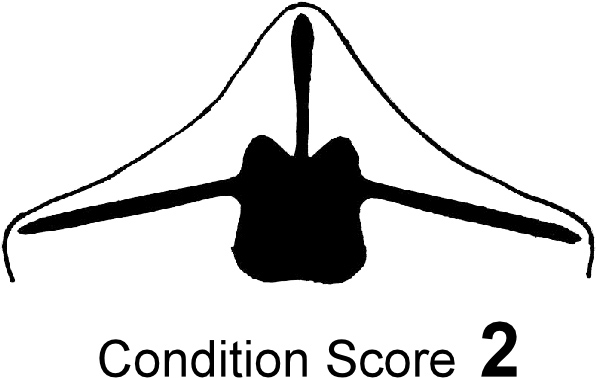Body Condition scoring (BCS) of sheep
Condition scoring sheep is an easy and accurate method of estimating the condition or 'nutritional well being' of your sheep flock. It requires an assessment of the amount of muscle and fat covering the backbone and the short ribs of each sheep. This gives a picture of the sheep’s store of energy. It is the best method for monitoring pregnant and lactating ewes but is also useful for monitoring the growth of weaners.
Condition scoring a mob at key times throughout the year gives producers key information to make management decisions in order to reach condition score targets for joining and lambing. Each assessment should only take a matter of seconds and condition scoring enough sheep to get an average of the mob will only take 20 minutes or so. It can be done while sheep are in for other husbandry activities.
Key scores
- No breeding ewe should be in score less than 2.
- Ewes in score 2.5-3.5 will provide optimum production and profitability.
- Ewes that are too thin (<2.5) will have poor production, increased risk of mortality and poor reproduction.
- Ewes that are too fat (>3.5) will have good production but stocking rate will be compromised which has a direct impact on profitability.
- No growing sheep (i.e. weaners) should be less than score 2.
The actual score of a sheep is important but the cost of getting sheep to that score is essential for profitability. Following a condition score profile for the ewe flock is recommended. Losing condition is inefficient as it takes at least three times the energy to put on condition than to maintain condition. It is only worth increasing condition on green feed or stubbles. Feeding grain early to maintain condition is preferable as grain feeding to increase condition is expensive.
How to condition score
- Randomly draft 25-50 sheep into a race or choose a random group from the middle of the mob. Many people choose a couple of animals from each race when drenching or doing some other animal husbandry task.
- The animal should be standing in a relaxed position. It should not be tense, crushed by other animals or held in a crush.
- Assess individual animals using the pictures below or watch the condition score video.
- Be sure to record the scores so that you can calculate the average. A simple method of calculating the median of the mob is to use the chart shown below.
Condition scoring is done by placing your hand on the sheep’s backbone and short ribs. The short ribs are in the loin area, between the long ribs (chops) and the hips. The cover of fat and tissue on the backbone and ends of the short ribs is assessed as well as the fullness of the muscle in between.
Figure 1 A cross section of the short ribs showing the muscle and fat cover for each condition score. A laminated card of these diagrams is available from the departmental offices.
BCS-1:
No fat and very little muscle on the backbone and ribs.
 |
| BCS-1 |
Seriously low body condition. Quite unacceptable — prone to disease and at risk of death.
BCS-2:
Good level of fat and muscle with rounded ends of ribs and top of backbone.
 |
| BCS-3 |
A good level for Merino ewes from joining to lambing and an ideal condition for young sheep.
BCS-4:
Condition score or live weight?
Condition scoring is often more useful than live weight in that it:
- doesn't rely on a weigh crate being set up — can be done anywhere a sheep can be yarded
- can be done without having to correct for wool growth or the influence of wet wool on liveweight
- needs no correction for weight of the foetus in pregnant ewes or the weight of fluid during lactation
- can be used on a mob of sheep with different frame sizes.
Condition score in relation to fat score
Many people are familiar with fat scoring through the marketing of prime lambs. Prime lambs are often assessed on fat score over the last long rib at the GR site 110 millimetres (mm) from the backbone. Fat score is an estimate of the total tissue depth (fat + muscle). The meat industry is moving towards assessing this in terms of the millimetres on the long ribs rather than a scale one to five.
There is a strong correlation between condition score and fat score measured as tissue depth at the GR site (in mm) but the relationship is not linear. The old fat score 2 (5-10 mm) covers the wide range in condition score from 2-3.5 (store to greater than forward store). Hence, when managing ewe flocks we believe it is more accurate to use condition score rather than fat score.
If you need more information on this topic, read this leaflet on methodology of body condition scoring in detail in Sheep.
Tags:
Sheep farming




